The Spiral Planetary Nebula is a planetary nebula located approximately 1,780 – 3,000 light-years away in the southern constellation Musca (the Fly). It has an apparent magnitude of 8.2 and apparent size of 90 by 62 arcseconds. It is listed as NGC 5189 in the New General Catalogue.
NGC 5189 was nicknamed the Spiral Planetary Nebula because, when seen through a telescope, it has a striking S shape similar to that of a barred spiral galaxy.
The nebula’s morphology has puzzled astronomers for centuries. About a decade after its discovery, English astronomer John Herschel observed NGC 5189 in his 18-inch reflector and described it as a “very strange object” with a “somewhat curved” central axis. He noted that it ended “in two masses brighter than the rest.” Herschel showed the nebula’s unusual S-shape in a drawing.
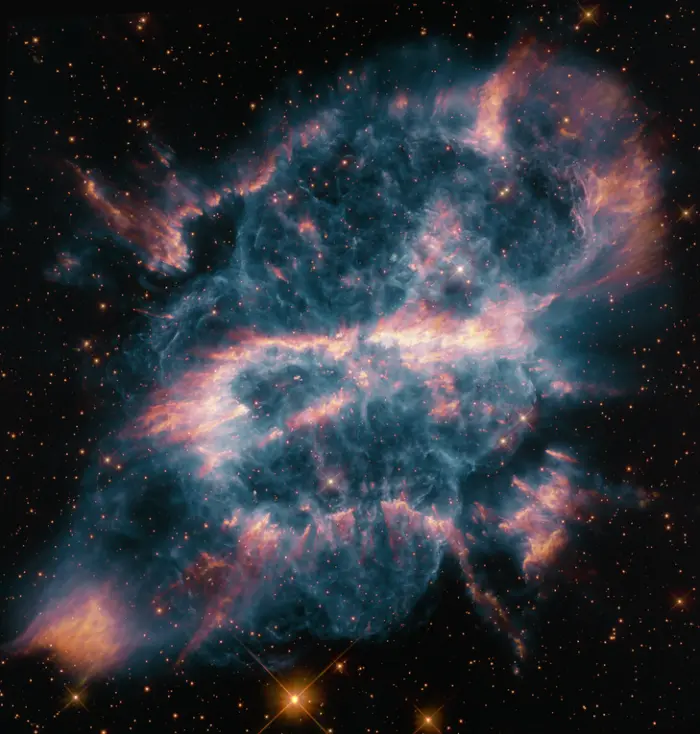
The Spiral Planetary Nebula (NGC 5189), image credit: Judy Schmidt (CC BY 2.0)
Planetary nebulae are ionized, hydrogen-rich shells of gas that form when a star similar to the Sun evolves away from the main sequence and becomes a red giant on the asymptotic giant branch. As the star expels material when it approaches the final phases of its life cycle, the ultraviolet light of the hot stellar remnant illuminates the surrounding nebula.
Like all objects of this type, NGC 5189 is the final brief stage in the life of a medium-sized star. When the aging star reached the asymptotic giant branch phase, it started to lose material at an accelerated rate. Once it ran out of fuel in its core, it ejected its outer gaseous envelope. The remnant core illuminates the expelled cloud of material, producing a bright nebula. The complex structure of the expanding clouds of gas reflects the mass loss process of the central star.
Planetary nebulae have nothing to do with planets. The term reflects the round shape and green or blue hue of these objects, which is reminiscent of those of the planets Uranus and Neptune in telescopes. The German-born English astronomer William Herschel may have been the first to use the term in the 1780s. Even though it is a misnomer, the term has stuck and is still in use today.
The reverse S shape and spiral patterns make NGC 5189 an unusual example of a planetary nebula. The cloud of gas has a knotty and filamentary structure and was produced with two nested structures. These structures are expanding away from the central star in different directions. The different lobes are believed to have been produced in different mass loss episodes of the progenitor star.
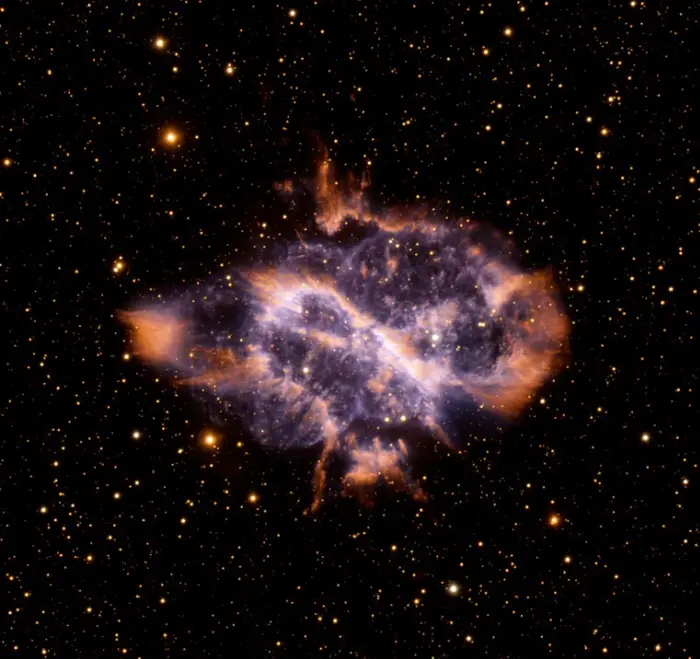
NGC 5189 imaged at Gemini South. NGC 5189, a chaotic-looking planetary nebula that lies about 550 parsecs (1,800 light-years) away in the southern hemisphere constellation Musca, is a parallelogram-shaped cloud of glowing gas. The GMOS image of this nebula shows long streamers of gas, glowing dust clouds, and cometary knots pointing away from the central star. Its unruly appearance suggests some extraordinary action at the heart of this planetary nebula. Image credit: International Gemini Observatory, U.S. National Science Foundation National Optical-Infrared Astronomy Research Laboratory (NSF NOIRLab) (CC BY 4.0)
The bright ring-like structure that twists through the nebula is composed of cometary knots and radial filaments. These are typically produced as a result of stellar winds and radiation from the central star. Even though they appear small in Hubble images of the nebula, each knot is comparable in size to our solar system.
The central star of the Spiral Planetary Nebula is part of a binary system, which explains the nebula’s quadrupolar structure. The presence of the companion star has affected the pattern of mass ejection, creating complex shapes and structures in the expanding nebula. A 2017 study suggested that the nebula’s low-ionization envelopes may be the result of a binary or triple star system evolution.
The central star is a rare low-mass Wolf-Rayet star with an estimated mass of 0.596 solar masses. The hydrogen-deficient star is catalogued as WD 1330-657 and HD 117622. It has a white dwarf companion locked in a 4.04-days orbit. The progenitor has a [WO1] spectral type, indicating that the star’s spectrum mimics the carbon sequence of massive Wolf-Rayet stars. With a temperature of around 165,000 K, it is one of the hottest central stars of planetary nebulae (CSPNs) known.
The Spiral Planetary Nebula contains multiple point-symmetric outflows (knots) and ansae, bright structures that typically appear along the long axis of planetary nebulae. Ansae are dense blobs of gas that form in the early evolutionary stages of planetary nebulae, along with jets.
Many planetary nebulae have ansae on either side. The bright examples include the Saturn Nebula (NGC 7009) in the constellation Aquarius, the Cat’s Eye Nebula (NGC 6543) in Draco, the Blinking Planetary Nebula (NGC 6826) in Cygnus, and the Ghost of Jupiter Nebula (NGC 4242) in Hydra.
However, the Spiral Planetary Nebula has more than one pair of ansae. A 1983 study found evidence for the presence of at least five ansae in the nebula. This indicates that the central star is in fact a binary system.
A 2017 study used images obtained with the Hubble Space Telescope Wide Field Camera 3 (WFC3) in 2012 to study the morphology of the nebula’s central region. The astronomers found that the inner 0.2 parsecs of the nebula around the binary system was produced in a more recent outburst of the central star in the post-AGB phase. They found two low-ionization envelopes within 55 arcseconds of the progenitor star, surrounded by highly ionized gas.
In 2019, observations with ESA’s XMM-Newton space telescope revealed that the nebula contained a carbon-enriched hot bubble that emits X-rays. The astronomers proposed that the origin of the X-ray emission was associated with the central star becoming carbon-rich due to a very late thermal pulse. Due to the eruption, it developed a very fast, carbon-rich stellar wind that powers the detected X-ray emission as it meets the nebular material.
These born-again episodes are not unusual in post-AGB stars. About a quarter post-AGB stars experience a very late thermal pulse, when helium is re-ignited and the stars return to the asymptotic giant branch. However, these episodes last only around 200 years before the stars start evolving into white dwarfs again.
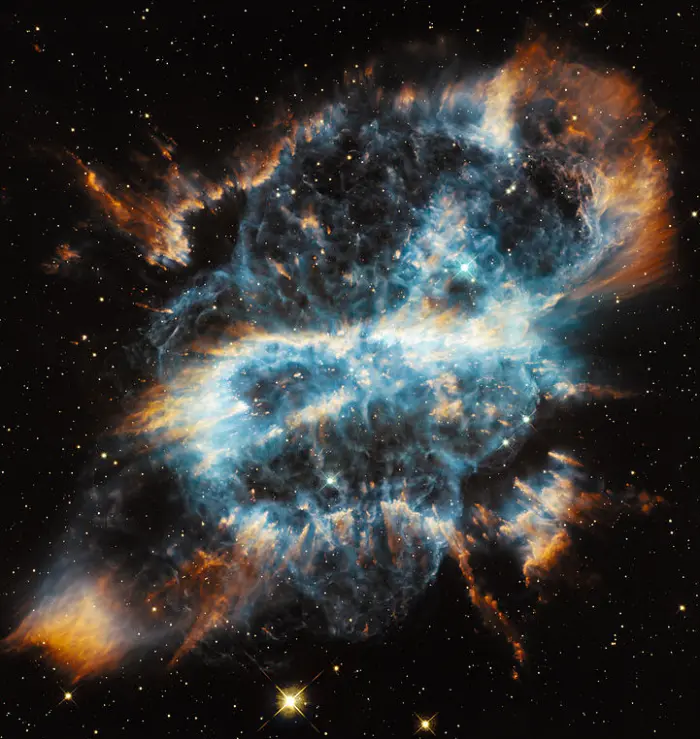
The NASA/ESA Hubble Space Telescope celebrates the holiday season with a striking image of the planetary nebula NGC 5189. The intricate structure of the stellar eruption looks like a giant and brightly coloured ribbon in space. Image credit: NASA, ESA and the Hubble Heritage Team (STScI/AURA) (PD)
Facts
The Spiral Planetary Nebula was discovered by the Scottish astronomer James Dunlop on July 1, 1826. Dunlop spotted the nebula with a 9-inch reflector at Paramatta in New South Wales, Australia. He catalogued the object as Δ252.
NGC 5189 was believed to be a bright emission nebula until the 1960s. In 1918, Campbell and Moore even believed it to be part of a group of three nebulae and not a single atypical object.
In 1967, American astronomer Karl Gordon Henize was the first to describe NGC 5189 as a quasi-planetary nebula after studying its spectrum.
The binary companion eluded astronomers until 2015, when observations with the Robert Stobie Spectrograph (RSS) on the 9.2-metre Southern African Large Telescope (SALT) detected a white dwarf companion to the central Wolf-Rayet star. The scientists derived a mass of up to 0.5 solar masses or 0.84 solar masses, depending on the inclination of the system, and found a 4.04-day orbital period of the binary.
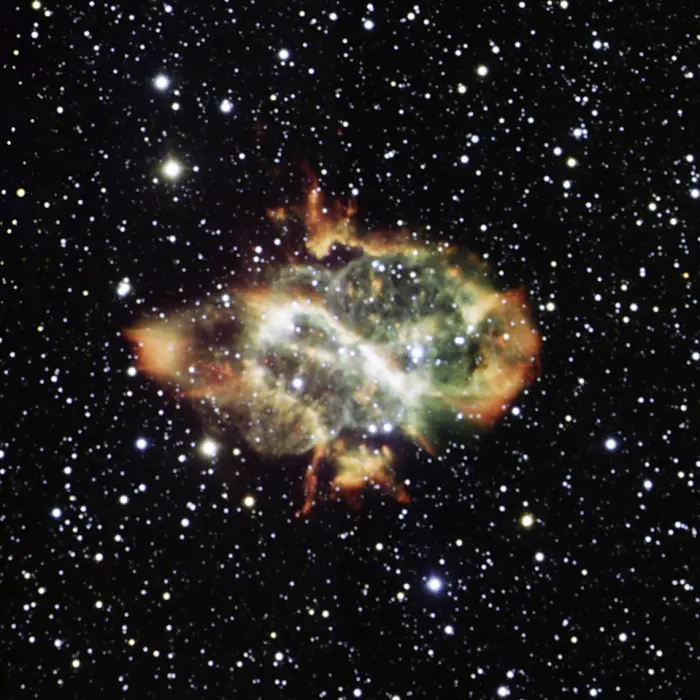
NGC 5189 is a planetary nebula with an oriental twist. Similar in appearance to a Chinese dragon, these red and green cosmic fireworks are the last swansong of an evolved star. At the end of its life, a star with a mass less than eight times that of the Sun will expel its outer layers, giving rise to a planetary nebula. Some of these stellar puffballs are almost round, resembling huge soap bubbles or giant planets (hence the name), but others, such as NGC 5189, are more intricate. In particular, this planetary nebula exhibits a curious “S”-shaped profile, with a central bar that is most likely the projection of an inner ring of gas discharged by the star, seen edge on. The details of the physical processes producing such a complex symmetry from a simple, spherical star are still the object of astronomical controversy. One possibility is that the star has a very close companion. Over time the orbits drift due to precession and this could result in the complex curves on the opposite sides of the star visible in this image. This image has been taken with the New Technology Telescope at ESO’s La Silla Observatory in Chile, using the now decommissioned EMMI instrument. It is a combination of exposures taken through different narrowband filters, each designed to catch only the light coming from the glow of a given chemical element, namely hydrogen, oxygen and nitrogen. Image credit: ESO (CC BY 4.0)
Location
The Spiral Planetary Nebula lies in the region of the Southern Cross and the Southern Pointers. The bright stars of Crux and Centaurus make it fairly easy to find. The nebula appears at the intersection of the imaginary lines connecting Rigil Kentaurus (Alpha Centauri) and Beta Muscae, and Hadar (Beta Centauri) and Gamma Muscae.
The constellation figure of Musca appears along the line extended through the Southern Cross. Alpha, Beta, and Gamma Muscae have apparent magnitudes of 2.69, 3.05, and 3.87, respectively, and are easily spotted from areas without too much light pollution.
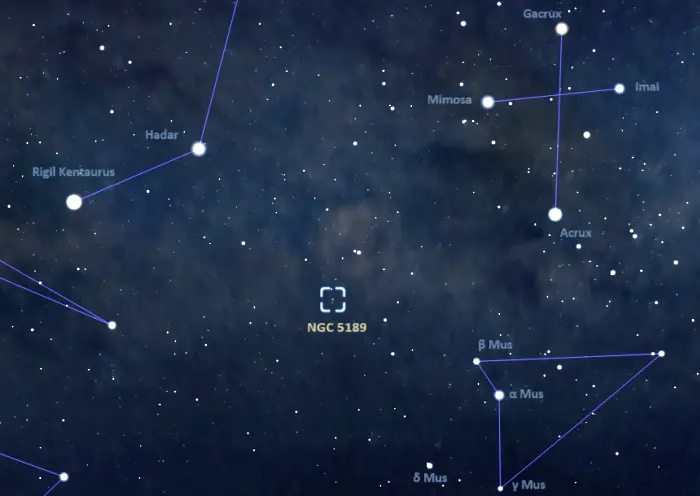
The location of the Spiral Planetary Nebula (NGC 5189), image: Stellarium
Even though it is relatively large and bright on paper, NGC 5189 has a low surface brightness and appears dimmer than its apparent magnitude would suggest when observed in a small telescope. The nebula can be spotted in a 4-inch refractor in good conditions. However, it is best seen in larger telescopes, which reveal the S-shaped curves and intricate structure around the long axis.
At declination -66°, NGC 5189 is visible from locations south of the latitude 23° N, but it never rises very high above the horizon for observers in the northern hemisphere.
The best time of the year to observe the Spiral Planetary Nebula and other deep sky objects in Musca is during the month of May, when the constellation appears higher above the horizon in the early evening.
Spiral Planetary Nebula – NGC 5189
| Constellation | Musca |
| Object type | Planetary nebula |
| Right ascension | 13h 33m 32.8780414224s |
| Declination | −65° 58′ 27.041428272″ |
| Apparent magnitude | 8.2 |
| Apparent size | 90 x 62 arcseconds |
| Distance | 3,000 light-years (900 parsecs) |
| Radius | 1 light-year |
| Names and designations | Spiral Planetary Nebula, NGC 5189, IC 4274, Gum 47, He2-94, PK 307-3.1, ESO 96-16, Sa2-95, ARO 515, VV 65, VV’ 114, PN Th 2-C, PKS J1333-6558, PKS 1329-657, PKS 1330-657, PN G307.2-03.4, Cen-Mus PN 4, WRAY 16-131, AM 1329-654, RCW 76, MGPS J133331-655829, PMN J1333-6558, TIC 341689253, KN Muscae (KN Mus), HD 117622, WD 1330-657, GCRV 8022, GSC2 S2131233378, GSC 09003-00669, IRAS 13300-6543, 2MASS J13333286-6558271, NSV 6296, WEB 11687, Gaia DR2 5863702868275424384, Gaia DR3 5863702868275424384 |